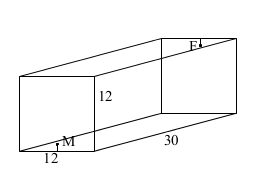Two and a half years ago, I worked for a teaching program at Queen's that could help first year calculus students get extra marks. It was called Math Investigations and its purpose was to show interesting problems that students might not see in a regular class. As a third year math student, I could solve most of them in a brief sitting but one problem called "two ants" eluded us and it just happened to be the first problem we presented.

My partner for TA'ing that section was
James McLean and we were later joined by
Rob Wang. We downloaded
problem sets picked out by the head of the program -
Peter Taylor - and he also happens to list the ant problem first. The premise is that a 12x12x30 box houses a male ant and a female ant and they are located on the square ends. One is eleven twelfths of the way between the floor and the ceiling, the other is eleven twelfths of the way between the ceiling and the floor. One ant wants to meet the other by crawling on the surface of the box - taking the shortest possible path. If you read
the solution we were given, you will see that it does
not prove which path is the shortest or give a real indication of how one might do so.